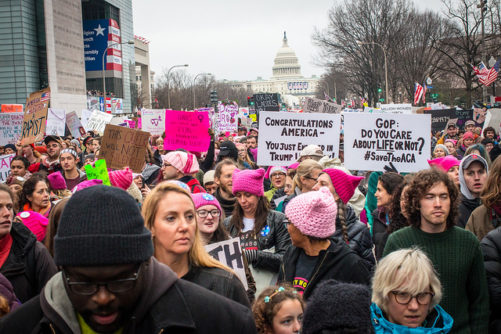
January 27, 2017; Washington Post and National Geographic
A week after thousands of women and their families gathered at the Capitol to rally for women’s rights, anti-abortion advocates held the 44th annual March for Life on Friday, organized by the nonprofit March for Life and supported vocally by the Trump administration. The rally was eclipsed, at least in national headlines, by the many protests across the country popping up spontaneously over the weekend in response to the president’s executive orders pertaining to immigration issued last week.
U.S. Vice President Mike Pence and administration advisor Kellyanne Conway addressed the pro-life crowds on Saturday, promising that President Donald Trump would end taxpayer funding of abortion and nominate a like-minded justice to the Supreme Court. The annual gathering saw renewed interest and energy with the election of Trump (who quickly reinstated the Global Gag Rule to stop nonprofits receiving federal aid from performing or promoting abortion abroad) and as a counter-protest to the Women’s March on Washington, which made headlines after several million people rallied across the world.
After higher-than-expected attendance at the Women’s March on Washington, including the second-highest subway ridership in the Metro’s history, the Washington Post reported that the Metro had normal ridership over the weekend, although extra trains were added to prepare for the March for Life.
March for Life organizers were characterized by the New York Times as feeling pressured to compete with the incredible Women’s March numbers from the week before. Official crowd numbers were not available, but Students for Life posted a two-minute time-lapse video of the march from the Washington Monument to the Capitol.
Meanwhile, it seems that the success of the Women’s March—and the rolling thunder of the Trump administration’s executive orders over the past week—has sparked renewed interest in civic engagement. In today’s social media age, millennials in particular have been accused of “slacktivism,” as online petitions and hashtags flourished but organizers didn’t see a similar interest in real action.
Now, scientists are speaking out and getting ready to stand up, with a March for Science in Washington in the works. As NPQ reported last week, several rogue Twitter accounts were set up by the National Park Service and the Environmental Protection Agency after Trump’s administration ordered a media blackout.
Sign up for our free newsletters
Subscribe to NPQ's newsletters to have our top stories delivered directly to your inbox.
By signing up, you agree to our privacy policy and terms of use, and to receive messages from NPQ and our partners.
“Since the election, there’s been a kind of boom of efforts by scientists to look for ways to constructively engage in anticipation of…what the [president] and others on his team have said about climate change and other issues,” says Peter Frumhoff, the director of science and policy at the Union of Concerned Scientists. “Many thousands of scientists are engaged and energized…by a desire to do something constructive and fear that the worst may be yet to come.”
The March for Science invitation on Facebook already has nearly 300,000 likes, and the official website promises a date to be announced soon for supporters to join the rally for “the responsible application of science to government.”
As National Geographic reported:
Doubters of science in general date to Galileo. Climate scientists have been an outspoken voice for as long as the government has been studying climate science… But the speed and ferocity with which controls on science appeared in the opening days of the Trump administration set off the fury on Twitter and inspired scientists from Maine to California to join a scientists’ march on Washington.
But will peaceful protest actually create change under the new administration? The #NoBanNoWall movement might be a timely test. ThinkProgress recorded more than 50 protests at airports, congressional offices, and city squares over the weekend. Although President Trump didn’t appear to personally back down from his order, Politico reported that “a growing number of Republican lawmakers came out Sunday in opposition to his refugee directive” and a White House official said people with green cards could return to the United States.
All of this “showing up” is also accompanied by other kinds of action (see feature), making the actions financially impactful and continuous. But there is no doubt that showing up counts.—Anna Berry













